The Cynedrycan Empire (Widonian: ᚳᚣᚾᛖᛞᚱᚣᚳᚪᚾ ᛖᛗᛈᛖᚱᚣᛖ - Cynedrycan Emperye) is a multinational empire located throughout the globe. The Empire consists of twenty one individual Dominions which together form the union that is Cynedryca. Cynedryca traces its roots to and was founded by the Kingdom of Widonia, whose culture is still the majority throughout the Empire. Other territories of the Empire include Krofluhellir, New Halford and, Ekjaldr. The Dominions are further divided into sub administrative units called Provinces.
Cynedryca is a parliamentary monarchy. Power is vested in the Empress, who shares her responsibility with the Parliament, the Prime Minister, and the Lord Chancellor to enact legislation. Cynedryca has two capital cities, Ōneida, home to the First Session, and Flōdceaster, which is home to the Second Session of Parliament. New Brāwichh is the largest city in the Empire and also the largest city in the world.
The Cynedrycan Empire of the 19th century was the largest empire in global history, encompassing more than a quarter of the world and dominating global affairs. Today, Cynedryca has the largest economy in the world with a GDP of ᚠ33 trillion. The national language of Cynedryca, Widonian, is the de facto lingua franca, and is spoken across the world in former Cynedrycan colonies. Cynedryca was the first nation in the world to industrialize, beginning in the 18th century, and was the first nuclear power, developing atomic weapons in 1945. Cynedryca remains a superpower, with extensive economic, cultural, military, scientific and political influence internationally. Domestically, the Empire supports a high human development index rating, and is a high income economy.
Cynedryca is a founding member of the Cynedrycan Commonwealth, an organization consisting of former territories, and is a founding member of the Congress of Nations, presiding over the Security Council and hosting the LEN headquarters in New Brāwichh.
Etymology
The name origin of the word "Cynedryca" stems from the largest island of the Brytic Isles in northwest Eporan: Cynedrycia. When these isles were conquered by the Kingdom of Widonia in 1490, a new empire was formed taking the name of the home island: Cynedryca.
History
Early History
Eyjanic people have lived on the continent of Eyjan since at least 4000 BC. By the 9th century BC, the Venesian Kingdom was a flourishing (but small) power located on the island. It would grow in size and power over the centuries, and would be the ancestor to the Cynedrycan people and language who would come a millennium later. Northland, by contrast, is home to the Uqausiq people.
Antiquity
The Venesian Kingdom would go on to be the predominant power in Northern Etharia, becoming the Venesian Republic in 502 BC. By the First Century BC, it would conquer territory in western Eporan. The leader of Venesia was given the title of Imperator (meaning king of kings, or emperor) and the Kingdom became officially known as the Venesian Empire. This put it into direct contact with the people residing in the lands referred to as "Trekká" (now modern day Treko). The Trurik people of western Trekká would stage multiple raids and ambushes on Venesian forces at the border. By 453 AD, the problem had grown so pervasive that an invasion of Trekká was made. The invasion would ultimately cost Venesia control of its empire, with the war lasting decades and depleting treasury. Finally, in 520 AD, the empire collapsed in Eyjan When Emperor Iovius IV abdicated from the throne, sending Eyjan into the dark ages.
Middle Ages
Widonia

Replica of a Widon-Seaxþ helmet.
The collapse of the Venesian Empire in Eporan during the 5th century AD brought an end to Imperial rule in the Brytic Isles. While traditionally described as a total decline in Venesian-Cynedryc civilization, the Treulochish Brot natives actually continued to upkeep Venesian urban centers and infrastructure into the 6th century. Other Brytic reverted back to their old ways, rebuilding their long abandoned hillforts and other traditional structures.
Coinciding with the withdrawal of Venesia was the migration of the pagan Widons and the Seaxþ, two closely related Pre-Venesian Eyjanic tribes whose ancestors had immigrated to the Eporan continent a millennia prior. The Widons and Seaxþ migrated from a region known as Widonesia in present day nortwestern Gatland. They arrived in southeastern Cynedrycia, within present day Cantwara, in the late 5th century, becoming the Widonics. Their settlement pushed the Brytic to the east of the island. The Widonics would embrace Christianity by the beginning of the 7th century.
In the 6th and 7th centuries, the Widonics began to form a series of small petty kingdoms in Cynedrycia, south of the Oirthirian Treulochs. This era, known as the Septarchy included these kingdoms: Ƿiglīs, Ésterlex, Cenūt, Mercasia, Norþūria, Soþurlex, and Ƿesturlex, though others existed for shorter periods at various points.

Kingdoms of the Heptarchy.

Queen Sæflæþ united Widonia in the 10th century.
Over the following centuries, the process of political consolidation continued. The 7th century saw a struggle for hegemony between Norþūria and Mercasia, which in the 8th century gave way to Mercian preeminence. In the early 9th century Mercasia was displaced as the foremost kingdom by Ƿesturlex. Later in that century escalating attacks by Visekian Vikings culminated in the conquest of the north and east of Cynedrycia, overthrowing the kingdoms of Norþūria, Mercaa and East Ƿiglīs. Ƿesturlex under Ecbert the Great was left as the only surviving Widonic kingdom, and under his successors, it steadily expanded at the expense of the kingdoms of the Viseklaw. This brought about political unification and the establishment of the Kingdom of Widonia, first accomplished under Queen Sæflæþ in 946.
Eyjan
In Eyjan, several peoples, notably the Slettanish and Hofnians, would fully embrace Christianity whereas other tribes reverted to Paganism. The Slettanish themselves moved into former Venesia, taking up their culture and language. Approximately one hundred years later in 650 AD several tribes centralized into a number of monarchies. These included the Slettanish Kingdom, Darkurian Kingdom, Grand Duchy of Hudiksa, Gerishian Kingdom and the Hofnian Kingdom. The Homarian peoples in eastern Eyjan remained tribal in nature.
High Middle Ages
By 1000 AD, the Brytic Isles consisted of the Kingdoms of Widonia, Oirthir, Laffey, and the various petty kingdoms of Gwynoch and Callaecia. All but Widonia were Treulochish. Being constrained on islands allowed the governments of these realms to somewhat centralize more than their contemporaries on the mainland, which suffered numerous wars and saw a strong nobility clash with their monarchy. Nevertheless society in the Brytic Isles was still very much feudal and the kings of the realms depended on the nobility for levies in times of war.
Great Northern Empire
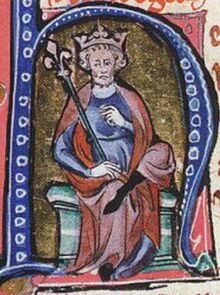
High King Knútr the Great
In the early 11th century, Knútr, the son of King Sveinn of Norðland and member of House of Hrafnhildr, sought to expand his influence and territory after his father's death in 1016. He led a series of campaigns to conquer Widonia, which was then ruled by King Liliwin. Following a series of battles and negotiations, Knútr and Liliwin agreed to the Treaty of Wudurbyrig that same year, which divided Widonia into two parts. Liliwin retained control of Ƿesturlex in the south, while Knútr ruled over the northern and eastern parts of Widonia, known as the Norðlaw. After Liliwin's death later that year, Cnut consolidated his rule over the entire kingdom. Knútr established himself as the High King of Widonia and was formally crowned in 1017. He ruled Widonia as part of his larger Great Northern Empire, which also included Norðland, Frisia, Leirhofn and Sléttania. His reign was characterized by relative stability and a policy of tolerance toward the Widonia nobility and church.
The Great Northern Empire was largely held together by the strong leadership of High King Knútr. When he died in 1035, his empire began to weaken as there was no single leader with the same level of authority to hold the diverse territories together. His sons, who each inherited the separate kingdoms, struggled to maintain control over the Empire and clashed often with local nobles who sought to reestablish their influence after the strong rule of Knútr. Ultimately the Empire began to fracture. Knútr's son, Eadwig, succeeded as King of Widonia and continued to rule until his death in 1040. He himself was succeeded by his brother Hlōþere, who also ruled as King of Norðland, bringing the two entities into personal union once more.
The death of Hlōþere in 1042 would be the ultimate end of the House of Hrafnhildr's rule in Widonia. The Widonian nobility sought to restore a Widonic king to the throne. Ēadweard Ƿesturlex, the son of King Liliwin, had been exiled to Vizelia by High King Knútr after his ascention to power in 1016. With the demise of Hlōþere, the nobles invited Ēadweard back to Widonia and crowned him as King Ēadweard I. Ēadweard's rule was marked by his strong Christian faith and efforts to promote religious reform. He would become known as "Ēadweard the Confessor" and canonized as Saint Ēadweard by the Church a century later in recognition of his great piety.
Secession War of 1068

The Tower of Flōdceaster dates to the reign of Magnūs I.
In the early 11th century, Robert II, Duke of Nordain, had taken the young Ēadweard Ƿesturlex into his court when the Widonian heir was forced into exile by Knútr the Great. Ēadweard would become an ally to the family and was chosen to be the godfather of Robert's grandson, Magnūs. The two would grow increasingly close over the years and Ēadweard served as a mentor to the young future Duke. When Ēadweard was invited back to Widonia and crowned King, he invited Magnūs with him and made him Earl of Sælwudu in recognition for his family's service to Ēadweard while in exile. When Magnūs's father died in 1061, he inherited the Duchy of Nordain. Magnūs would continue to be a crucial ally to King Ēadweard the Confessor and when it became apparent that the celibate king would not have a son, Magnūs was chosen by the King as his heir.
In 1068, Ēadweard the Confessor died. His brother-in-law, Ælfric, a member of the politically powerful Wynnstan family, was chosen by the Witan to reign as next king. The Wynnstans were made Earl of Ƿesturlex a generation earlier by Knútr and were instrumental to Ēadweard becoming King. Nevertheless, the Widon-Vizelian Magnūs Devereux, now Earl of Sælwudu and Duke of Nordain, had enforced his claim to the royal throne, claiming that Ēadweard had chosen him as successor a decade prior. Ælfric was crowned instead, gaining votes amongst the border nobles who held swathes of land at the far ends of Widnonia and feared a foreign king. These border nobles contributed to the vast majority of Ælfric's levies and funds in the coming war. Magnūs would rally his forces into the south and defeated Ælfric's army on September 9, 1068. Ælfric retreated to Flōdceaster, which was sieged. He would ultimately surrender his crown and Magnūs would become King and gave rise to the Devereux dynsaty.
As King, Magnūs would institute various traditions and customs from his ethnic homeland of Vizelia, introducing Vizelian knighthood, concepts of chivalry, and heraldry. In his position, he granted lands to and ennobled Vizelian lords into the Widonian aristocracy, dethroning the defeated border nobles who supported King Ælfric These Widon-Vizelian noblemen thus were granted the most heavily militarized lands in Widonia and due to their locations on the border, built up a series of castles and fortresses. The Widon-Vizelian lords and knights would become significantly important in the coming centuries as the defenders of the Widonian crown.
Branderlandish invasion
See also: Battle of Hægelshām

King Theuderich of Branderland is killed by an arrow to the eye during the Battle of Hægelshām.
After ruling for two years, King Magnūs would face an invasion from the mainland. The Kingdom of Branderland, a state within the Holy Venesian Empire, was ruled by King Theuderich. He was part of a faction that opposed what was perceived as the tyrannical rule of Emperor Wilhelm III, who sought to centralize the empire against the wishes of his vassals. Open rebellion against the Emperor was avoided, however the King sought to expand his power base beyond the HREs borders. A suitable claim was found in Widonia. Theuderich was a descendant of the House of Ƿesturlex which had previously ruled the Kingdom up until the death of Ēadweard the Confessor.
King Theuderich sought to press his claim. Widonia in 1070 had been especially pummeled by viking raids, as it had for the past several hundred years. The Widonia, which was already much smaller than Branderland, was taken to be easy pickings. On August 10, after marching into Frisia and crossing the Brōtic Channel, King Theuderich landed troops on the shores of southern Widonia. His armies began a series of raids against the population, forcefully taking grains and other materials to supply the invasion. By August 12, King Magnūs mustered his army and intercepted Theuderich and his forces near the town of Hægelshām. A battle commenced, culminating in a second, unexpected cavalry charge that had managed to route a segment of Theuderich's forces. In the chaos, the King of Branderland took an arrow to the eye and died nearly instantaneously. Without effective leadership, the Branderlandish forces quickly crumbled and retreated southwards, back across the channel where they had come from. The invasion of Widonia had proven to be an utter failure. The relatively centralized (for the era) Widonian society allowed for a quick response to the invasion, which when coupled with centuries of battling invading Vikings allowed the Widonians to to gain the upper hand. Widonian longbowmen and heavy cavalry also proved highly effective against the infantry heavy Branderlandish. The Battle of Hægelshām was the last time in history a foreign army marched on Widonian soil. The event further deepened mistrust Widonians had against the continent.
Anarchy Period
King Henrī I died in 1135. His son and only legitimate heir, Hrodbert, had died over ten years in 1122. His daughter, Empress Mæþilda, former consort of the Holy Venesian Empire, was his preffered heir and Henrī would secure her claim among the nobles years before his death. Mæþilda would be crowned as queen after her father's death, but saw her cousin, Stēfan, form a rival claim to her position. A civil war would begin, leading to an era known today as The Anarchy. After a decade plus of fighting between the factions, Mæþilda would be captured by forces loyal to Stēfan in 1148 and was forced to denounce her claim to the throne. With Stēfan now as king, the Kingdom once again lacked a legitimate heir to the throne. Thus, Stēfan adopted Henrī; Mæþilda's son from her second marriage to Hroðgar Earl of Ōswin. This cemented the rule of the House of Ōswin for the next several centuries.

Map of the territories of the Ōswin Empire, a collection of lands ruled by House of Ōswin.
Late Middle Ages
Ōswin Empire
The Ōswin Empire is the term used by contemporary historians to describe the personal union of lands ruled by the House of Ōswin until the end of the 15th century. It should be noted that this personal union was never formally called an empire in its own age as it was a collection of shared territories as opposed to a unified entity. Nevertheless, the union is of great historical importance as it is the immediate predecessor to the Cynedrycan Empire and marked an era of Widonian expansion into surrounding lands.
Frisia
Empress Mæþilda had inherited the lands of Frisia after the death of her husband and Holy Venesian Emperor Chlodwig IV. Prior to his election as Emperor, Chlodwig had been King of Frisia and without heir, the title immediately went to his wife upon his death. The ascension of the unrelated Chlodwig V as Emperor meant that Frisia, which had never formerly been part of the HVE, had been severed of all ties to the Empire. With Mæþilda as Queen, the throne would pass to her son, Henrī II upon her death in 1167. He would jointly rule Widonia and Frisia in personal union, giving rise to the Ōswin Empire.
Callaecia
In the 12th century Callaecia was still under the control of various petty kingdoms and other disorganized entities. in 1169, the disposed King of Dunloughra, Cormac O'Riordan, sought the assistance of Widonian knights in retaking his lands. He recruited the aid of the Widon-Vizelian knight Cenred de Dupont, who with his forces, successfully captured key Callaecian positions and settlements. The Widon-Vizelians established footholds in their acquired regions, building castles and establishing lordships to maintain control. Concerned about the growing influence of his own nobles in Callaecia, King Henrī II of Widonia decided to intervene. He personally led an expedition to Callaecia in 1171, recieving the submission of several Callaecian kings and lords who recognized him as their overlord. The newly established title of King of Callaecia was granted to Henrī II, expanding his personal union to include Widonia, Frisia, and Callaecia. The Widon-Vizelian knights too would gradually come under the vassalage and protection of Henrī II and later his two sons, King Richard (1189 - 1199) and King Jon I (1199 - 1216). By the reign of Jon's son, King Henrī III (1216 - 1217), Callaecia would fully be under the rule of the House of Ōswin.

A reconstruction of the city of Brāwich as it appeared in the 15th century showing the city walls and Brāwich Castle.
Gwynoch
The first Widonian incursions into Gwynoch date back to the 11th century, with Widon-Vizelian lords and Marcher lords (nobles given land along the Gwynochian border) establishing control over border regions. Magnūs I, the first Widon-Vizelian King of Widonia, initiated early efforts to subdue Gwynoch, but these attempts were limited. The most significant phase of the Widonian conquest began under King Ēadweard II in the late 13th century. Ēadweard II was determined to assert Widonian control over Gwynoch. In 1277, he launched a military campaign against the Gwynochian prince Rhys ap Morgan, resulting in the Treaty of Llynwen, which forced Morgan to cede territory and pay homage to the Widonian king. A flare in tensions in 1285 resulted in tge Gwynochian war for independece, led again by Morgan. Morgan's forces were defeated by Ēadweard II and the Gwynochian prince was killed in battle, putting an end to the rebellion. The Statute of Abercymroch in 1286 formally incorporated Wales into the legal and administrative framework of the Widonian Crown, dividing it into shires and introducing Widonian law. Gwynoch would not be separate from Widonia until 1967, when it became its own Dominion of Cynedryca after a century of public support.
Audrifeld
The Duchy of Audrifeld, located in between Branderland and Gatland on the eastern Widlicetan coast, was an elector state in the Holy Venesian Empire. In 1393, Ēadweard II inherited the Duchy after the passing of his cousin, Duke Gūnþer V. Audrifeld would become the second continental Eporan territory in the Ōswin Empire and Ēadweard II became an elector of the HVE. Within Audrifeld, the Widonian King was a vassal of the Holy Venesian Emperor. Outside of the Duchy however, the Ōswins clashed frequently with the HVE and made enemies out of numerous emperors.
Gatland

Widonian Gatlandic Conquest
For centuries, the Kingdom of Gatland had been separated from the affairs of the Brytic Isles by the Widlicetan Sea. Instead, it had become occupied by Viking incursions numerous times and frequently skirmished with the Holy Venesian Empire to the south and east. In the mid 14th century, under the reign of King Magnūs III, Widon-Vizelian aristocrats began expanding their power base and influence into Gatland, marrying the daughters of Gatlandic lords and purchasing land directly from the King of Gatland, becoming local titled nobles. The reign of the tyrannical Gatlandic King Sigurd IV at the end of the century sparked a period of unrest and division among the nobles of Gatland. The Widon-Vizelian landholders allied with the native Gatlandic nobles who resisted Sigurd's rule and convinced them to invite Widonian King Maxim II into the country to directly contest Rādulf's rule. In 1403, a proposal was sent to Maxim II promising him the Gatlandic throne in exchange for his support. The Widonian King accepted and the Widon-Gatlandic War saw Widonian and rebel armies fighting loyalist Gatlandic forces. Maxim II was victorious and the Treaty of Volsburg, signed in 1405, made Maxim II King of Gatland.

Coronation of Maxim I; aged 10 in 1377.
Grēatēd Writ
In the early 13th century, King Jon I faced a series of political and military challenges, including conflicts with his vassals, and disputes with the Church. The discontent among his vassals, in particular, led to a rebellion against his oppressive rule and heavy taxation. In the spring of 1215, a group of rebel barons, led by Ēadgils Beocca, met with Jon at Woodgate, a meadow along the River Gwy near Windlesora Castle. The negotiations resulted in the drafting of the Grēatēd Writ, a document consisting of 63 clauses. The document aimed to address various grievances against the king and establish certain principles of governance. Some key provisions included protections against arbitrary imprisonment, limits on taxation without the consent of the barons, and the requirement for a legal process before property could be seized. The Grēatēd Writ also emphasized the idea that the king was not above the law and that his powers were subject to legal and customary constraints. The document became part of Widonian law and formed the basis for future legal principles.
The Civil Wars

Battle of Teoxburh, 1471.
The Civil Wars were a series of conflicts that took place in Widonia during the 15th century, primarily in the latter half of the century. This complex and protracted conflict was fought between two rival branches of the House of Ōswin: the House of Loncastre and the House of Brāwich. The wars extinguished the last male line of the house of Loncastre in 1471, leading to the Tūnburh family inheriting the Locastrian claim to the throne. Following the war and the extinction of the last male line of the house of Brāwich in 1483, a politically arranged marriage united the Houses of Tūnburh and Brāwich, creating a new royal dynasty which inherited the Brāwichist claim as well, thereby resolving the conflict.
The conflict began in earnest in 1455 with the First Battle of Alderthōrpe, where Brāwichist forces defeated the Loncastrians. Over the next three decades, the two sides engaged in a series of battles and skirmishes, including the Battles of Tewtun (1461), Bærnet (1471), and Teoxbury (1471). The Brāwichists, led by Wilhelm and later his brother Magnūs V, gained and lost the throne multiple times. The Loncastrians, led by figures like Jon II and Richard Tūnburh (who later became Richard II), also had periods of ascendancy. The Wars culminated in the coronation of Richard II as King of Widonia in 1485 and the rise of the House of Tūnburh which continues to rule to this day.
Formation of the Cynedrycan Empire
As the King of Widonia, Callaecia, and Gatland, Richard II was faced with the tumultuous task of consolidating his hold over such varied and diverse lands. While Frisian succession laws prevented him from holding the Frisian throne and this claim was lost, Richard II was still responsible for maintaining the numerous regions acquired under the reign of the Ōswins. First and foremost, Richard II sought to consolidate his holdings into one single entity and title. In 1490, with the approval of his lords, Richard II established the Cynedrycan Empire from his sovereign lands and was crowned once again, this time as Emperor. Naming his empire after the island of Cynedrycia, it became apparent at the very beginning that this was a Widonian dominant empire. The Widonian Parliament was transformed into the Imperial Parliament. The rest of the Empire adapted to Widonian laws and legal customs in the form of Imperial law.
Renaissance
Formation of the Widonic Church
Richard II was succeeded by his son, Magnūs VI, who became Emperor in 1509 at the age of 17. Magnūs was an archetypical renaissance man. He was multitalented, being an accomplished poet, songwriter, musician, athlete, and jouster. A handsome and charismatic man, Magnūs quickly found favor with his court and Parliament. In 1513 the Emperor launched an invasion of Frisiain an attempt to reclaim the throne lost 28 years prior. Despite initial success, the invading Widonian army became bogged down in a stalemate against the Frisians. Magnūs called a parliament in March 1414 and attempted to secure a tax to fund the increasingly expensive conflict, though this failed to reach agreement. Magnūs took measures of taxation into his own hands via loopholes in the law, which required the Parliament to authorize raising a tax. As Emperor, Magnūs had the sole power to declare an emergency, which he did in 1515. By declaring an emergency, he had additional powers which allowed the crown to raise levies and funds from the border counties to supply towards the conflict on the mainland. This was begrudgingly accepted by the border lords, who recognized the right of the crown in emergency. A year later, in 1516, Magnūs began mandating that the border levies and collection be applied to internal counties, creating discontent among their lords.
In 1518, Magnūs occupied approximately two thirds of Frisia. He would hold onto this land for over 10 years, claiming the contested title of King of Frisia. Occupation continued to be an expensive endeavor. The Emperor continued mandating monetary levies from the internal counties, prompting growing concerns that he was illegally levying taxes. Aware of the cracks appearing in his court, Magnūs grew paranoid and authoritarian. Arrests were made on his most vocal critics for the crime of treason, with Magnūs imprisoning them for years on end. When a rebellion in Frisia once again strained the treasury in 1529, the Widonian forces were left with no other choice but to withdraw, serving to further drive Magnūs into a fit of paranoia as he believed his generals had backstabbed him into defeat.
By 1530, Magnūs's largest critic and rival would see his arrest. The Bishop of Manham, Walter Brown was executed in the Tower of Flōdceaster. A close ally of the Papacy, Brown's death enraged Pope Leo XXI, who swiftly excommunicated Emperor Magnūs VI from the Catholic Church. Not to be outdone, Magnūs promptly issued the Acts of Sovereignty. This declared that the Emperor was the supreme head of the church in Cynedryca and stripped the Pope of all authority within the empire. The Acts of Sovereignty was part of the broader Protestant Reformation within Eproan, with the Catholic Church being upended in Flondar, Branderland, and beyond. A new Christian faith was born in Cynedryca; Widonicism. The Widonic Church was unique among the protestant sects in that aside from its rejection of the papacy, Widonicism continues Catholic traditions and ceremonies to this day. Indeed, an alternate name for Widonic Christianity is Widonic Catholicism, emphasizing the continuity of the church with the Catholic Church which existed in Widonia prior to the Acts of Sovereignty.

Empress Beātrīce reigned for nearly half a century.
Beātrīcian Era
Magnūs VI would die in 1547. He was succeeded by Emperor by his young son Magnūs VII, who would die some few years later in 1553. With no surviving male heirs, Magnūs VII was in turn succeeded by his older sister, Empress Alice. Alice notably attempted to restore the Catholic Church in Widonia and Cynedryca. She had several hundred religious dissenters burned at the stake, but would ultimately be thwarted in her undoing of the reformation by Parliament. Alice, like her younger brother, would only rule briefly as she passed in 1558, reigning for 5 years. The crown would pass to Alice's younger sister; Beātrīce. As the second eldest of Magnūs VI's four children, Beātrīce was raised outside of the court, never expecting to inherit the throne. She was tutored Elisabeþ Ashtor, the Countess of Carlīa. Elisabeþ herself was the only child of the Earl of Carlīa and she held the title in her own right.
Eight Years War
Main Article: Eight Years War
See also: Cynedrycan Anphilos
War of Anphilosian Independence
The aftermath of the Eight Years War brought a fundamental change to colonial policy in Anphilos. Prior to the conflict, policy from Flōdceaster could best be described as "hands off", allowing the local colonial proprietors and governors to manage affairs on their own. With the war's conclusion, Parliament took a marked interest in the affairs of the colonies. First and foremost, in 1764, taxes were raised on the colonists to help pay for debts issued during the war. While this itself would ordinarily not cause much discontent, Parliament began impeding on the decision making that prior was typically left to the provincial legislatures. In 1766, delegates from the Anphilosian colonies met together in Penceaseter, New Norþwich to begin discussing their grievances towards Parliament. Known as the Conference of Penceaster, the delegates initially sought compromise, however after their pleas were ignored in Flōdceaster they began to discuss more radical measures.
On July 3, 1767, 12 of the 19 colonies represented in the the Conference voted for independence. Those that voted to remain within the Empire were the southern slave holding colonies: Marieland, Mægdenia, New Hrædrwyck, Maxima, New Bexshire, Bajamar, and Geamaca. These provinces had a more aristocratic population than the north, a population weary that a disruption in trade could impact the sales of the cotton they produced from their lands.
Industrial Era and Colonialism
Main article: Victorian Era
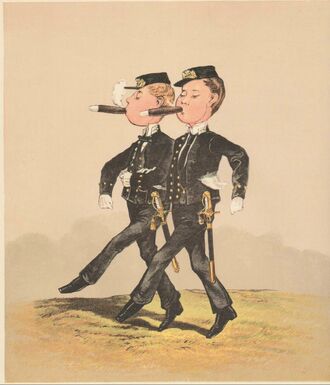
Cynedrycans during the Victorian era saw their empire as the height of global civilization. This self righteousness and confidence influenced Cynedrycan racial theories of the era.
In the previous century, Cynedryca began looking outwards and would establish various colonies across the world. By the 19th century, these colonies would transform the formerly concentrated Cynedrycan Empire into a major colonial superpower and the largest empire in global history, vastly surpassing even the Trekkish Empire.
Developments in technology and manufacturing quickly spread from the mainland to Cynedryca, or developed in Cynedryca outright; forever changing the lifestyle of the working class from rural farmers to urban dwellers. The cities sprang up in the interior along various river ports ports and railroad lines, becoming established centers of trade and commerce. The industrial revolution was born in Widonia. Coal from Gwynoch fueled industry in the midlands, creating a new era of mass produced goods. From Widonia, the industrial revolution spread to Gatland, making its way to Ninhundland. New Widonia in Haþmēre was the first region in Anphilos to industrialize, beginning in the latter 18th century.
All this has resulted in the 19th century being known as the "Cynedrycan Century." The reign of Empress Victoria II (1909-1912) brought a stylish young woman to the throne, forever influencing the trends of the era both within the Empire and outside. Her early death would result in her younger brother taking the throne, Emperor Gyrg III.
Early 20th Century
World War I
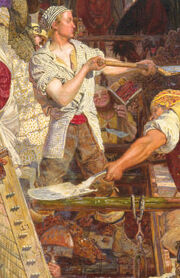
Cynedrycan laborers in 1850s Flōdceaster.
Interwar Period
Following the massive increase in military spending during WWI, the government once again downsized the Army for the inter war period.
Domestically, the 1920s was a period of peace and optimism. Modern inventions, such as the airplane and the radio, as well as convinces such as the refrigerator and the washing machine, became useable for the average citizen. With much of the rest of Eporan in ruins from the war, Cynedryca provided much of the goods and manufacturing for the rest of the continent, providing unheard of wealth to Cynedrycans. This wealth would be very unevenly distributed into the upper classes however. Income disparity in the 1920s would prove to be a major social and political issue.
In 1924, women would receive the right to vote for the first time. Overnight, the voter base nearly doubled and now MPs running for office had to now tap the female vote if they wanted victory at the polls.
While the 1920s would be known for its booming economy and excess, it would quickly come to an end. On February 28, 1930, the New Brāwichh Stock Market crashed. Billions of sterling were lost overnight and the economy spiraled out of control. The crash would continue spreading throughout the liberal capitalist world until eventually a global depression loomed over all.
The Great Depression spelled the end for many states in Eporan who turned to extremism, whether it be like fascism in Ninhundland or Communism. Nevertheless democracy in Cynedryca held strong and a labour government would be elected. The federal government greatly increased the public sector and public works project brought employment to millions of people.
War would come in 1933, bringing Cynedryca into a conflict in southern Akrifa between the former colonies of Kaldesia and Ekhaya, which had proven hostile to each other since both gained independence in 1918. Kaldesia, a member of the Commonwealth, requested the assistance of other member states in 1932. Cynedryca entered the war several months later, ultimately fighting to victory alongside the Kaldesians. While the Kaldesian War was not particularly bloody nor taxing on the Cynedrycan treasury, it did have the effect of providing experience for a generation of officers on modern warfare.
World War II
On July 20, 1940, Ninhundland invaded and annexed Galavaria. Having been under fascist rule for the past decade, the Ninhundish had grown increasingly grandiose in their visions of an Eporan unified under their rule. Galavaria, a fellow Guthic nation that in the past had been part of Ninhundland, was logically the first choice for a burgeoning fascist empire.
The largest critic of Ninhundland at the time was Emperor Magnūs XII, who broke with tradition and was outspoken in his criticisms of fascism and aggression on the continent. Prime Minister Baldwin Brnyeulph was notably silent regarding affairs in Eporan and strongly believed that Cynedryca should steer an isolationist course away from the mainland. Thus it was the Emperor who controversially led the anti-fascist anti-Ninhundish sentiment which grew among the Cynedrycan public. By and large most Cynedrycans remained firmly anti war despite this.
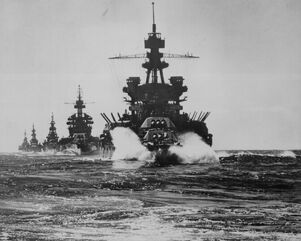
Cynedrycan dreadnoughts patrol the Medietas Ocean.
Gerhardt Himdach, the dictator of Ninhundland, greatly feared that growing Cynedrycan attention towards Eporan could increase the popularity for direct intervention. With the Emperor being the loudest voice against Himdach's rule, he conspired against Magnūs. On October 30, 1940, the Emperor of Cynedryca was assassinated. Evidence quickly made it clear that the culprits were Ninhundish agents. The Cynedrycan public became enraged at this direct attack on their sovereign. While Himdach hoped to silence talk if intervention, the assassination did the exact opposite. Parliament almost immediately voted no confidence in Baldwin Brnyeulph and the pro-war Wynnstān Ofa was appointed as Prime Minister. On November 1, the Cynedrycan Empire declared war on Ninhundland.
Post-War
Cynedryca entered the postwar world as, for a brief time, the world's only atomic power, though it was weary from nearly a decade of conflict. The government once again funded reconstruction, rebuilding the ruins of partially destroyed cities in Gatland and Oceania.

1950s New Brāwichh
First Delta War
On June 10, 1994, a jihadist attack on the International Trade Center in New Brāwichh on killed nearly 3,000 people. The attack was carried under the ultimate authority of King Shihab of Terani, who utilized jihadist sentiment to strike at the Republic of Cynedryca. War was declared on the Kingdom of Terani, with the Cynedrycans invading the country and capitulating the government in a matter of weeks.
Second Delta War
On September 26, 2015, a Cynedrycan airliner was victim to a suicide bombing attack, killing all individuals on board. The terrorist organization Islamic Union claimed responsibility for the attack and declared a war of Jihad against Cynedryca. As a result, the Prime Minister responded with a declaration of war against the Islamic Union, and its host state, Terani. Known as the Second Delta War, the Cynedrycan military launched an invasion into Terani and Hajistan, decisively defeating the IU and allied Teranese and Hajistani militaries and capturing the capital city of Al-Zahalla.
Geography, Geology, and Climate
Geography

The Eoforwic Dales of North Widonia.
Cynedryca is a global empire and as such has an incredibly varied geography. The heart of the Empire, the Brytic Isles, is an archipelago off the coast of northwestern Eporan in the Medietas Ocean. The two largest islands of the isles includes Bryten, to the east, and Callaecia, to the west. The southern two thirds of Bryten consists of Widonia, whereas the northern third is Oirthir On the eastern stretch of Bryten, bordering only Widonia, is Gwynoch. The Brytic isles are temperate, however the far northern reaches of Callaecia and Oirthir are boreal forest. As a whole, the isles receive more precipitation and less sunshine than mainland Eporan. Widonia itself is divided into three regions: the South, the Midlands, and the North. These regions roughly corresponds with the three major Wido-Seaxeþ kingdoms: Ƿesturlex, Mercasia, and Norþūria respectively. As a general rule, the Midlands and the North have the most large cities in Widonia, however the largest, Flōdceaster, is in the south.
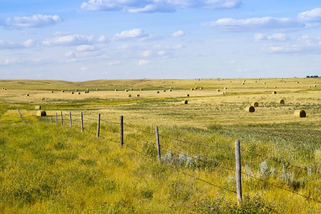
Farmland in Eastern Gatland.
The Widlicetan Sea separates the Brytic Isles from mainland Eporan. East of here is Gatland. Gatland is bordered by Visekia to the north, Ninhundland to the south, and the Holy Venesian Empire and Galavarian to the east. This region is collectively known as "Eporīce", a name which refers to the continental lands of Cynedryca. Gatland is the flattest region of Cynedryca, being the western reach of the Hezporan Steppe. The interior of Gatland is home to a massive expanse of agriculture that stretches for thousands of miles, continuing into the HVE. In general. Eastern Gatland is more dry than the western shores of Gatland alongside the Widlicetan Sea. Southern Gatland has the Beorgwudu Mountains, which form the border with Ninhundland. The Folafoter River, the longest on the continent, forms the border between Gatland and the HVE, as well as Gatland and Galavaria. Northern Gatland transitions into boreal forest north of the Grāuel Mountains. In Visekia, which is almost entirely boreal forest, the coasts are lined with glaciated fjords. Several large mountain chains cross the country, making Visekia the most mountainous part of Eporīce.

Northern lights over the boreal forests of Northland
Cynedrycan Eyjan exists entirely within the continent of Eyjan, and is located in the Glacialis Ocean, above the arctic circle. Eyjan is the most northerly major landmass in the world.
Northland is in the western hemisphere, sharing a sea border with Inukpak to the east and Dougland to the west. It is traditionally considered to be a region of Anphilos, however the landmass of Northland is indeed an island separated from the rest of the continent. Southern Northland is primarily coniferous, with boreal forest being the predominant biome. North of here is the Northlandic Ice Cap, the largest in the northern hemisphere.
Located on the eastern coast of the continent of Anphilos is Haþmēre, which shares a land border with Kurata to the south and Noremacia in the north. Haþmēre has temperate forests, with some Boreal in the north.
Gulland is on its own continent of the same name. The Dominion has a very large desert in its interior known as the outback, but also has a rain forest on a peninsula known as Cape Brāwichh: Lēce Rain Forest.
Sirenia consists of a series of Islands and atolls in the Sirenian Ocean.
West Akrifa is in Akrifa.
Eyjan is well known for volcanic activity, as it is located on the conjuncture of three separate Teutonic plates.
On 21 March 2010, a volcano in Eyjafjallajøkull in the south of Ejyan erupted for the first time since 1821, forcing 600 people to flee their homes. Additional eruptions on 14 April forced hundreds of people to abandon their homes. The resultant cloud of volcanic ash brought major disruption to air travel across Etharia. An even larger eruption occurred on April 11, 2020, when the Hameentrish volcano Mt. Kallioinen exploded in the largest eruption in well over a century. The volcano ejected so much ash and debris into the atmosphere that the global climate of 2020 is expected to be several degrees cooler than average, leading to a shorter summer and a long bitterly cold winter.

Eruption of Mount Apitkä.
Northland is less volcanic. The southern half of the island consists of dense forests, with agricultural fields lining river valleys and the outskirts of cities.
Climate
Government and Politics
Cynedryca is a Parliamentary monarchy in which power is vested in the Empress and her Parliament as well as its Prime Minister, who appoints individuals known as Ministers to run various cabinet positions within the government.

The Parliament is an ancient legislative institution that is divided into two houses: the upper house, known as the House of Lords. The House of Lords is headed by a Lord Chancellor, who is elected by the Ealdormen. The current Lord Chancellor of Cynedryca is The Earl Moorington, Gēoffrey Yorke. The lower house is the House of Commons, whose history goes back to the middle ages. The House is headed by a Prime Minister, with Edward Grīwulfsson currently incumbent.
The Crown of Cynedryca, held by the monarch, is the symbolic source of power within the Empire. While her powers are in practicality extremely limited, the Empress can still sack Parliament and call for new elections, though this hasn't been done since the 1900s. The monarch today is an apolitical figure who appoints government ministers on the advice of Parliament. While the Monarch also holds the power to declare war, this is again done through Parliament.
Politically, Cynedryca has long been the dominant proponent of liberal democracy on the world stage. Prior to the 20th century, it was one of the few democracies in Eporan and was by far the most significant.

Dominions
Cynedryca is divided into 16 Dominions, each of which is governed by a Magistrate. While Dominions must comply with federal legislation, they are free to pass their own legislation and raise taxes. Dominions are considered regions within the Empire which are home to a large and distinctive culture. The dominant language of a country will generally be recognized as a national language of Cynedryca.
There are eleven Dominions within the Cynedrycan Empire: Widonia, Kymasia, Visek, Oirthir, Gwynoch, Callaecia, Hvidovia, Leirhofn, Hameentra, Northland, West Akrifa, Oceania, Turgia, Gatland, Haþmēre, Treulochia and Gulland . five of the nations have their own royal families and monarchies who administer their kingdoms.
All five of the monarchies are hereditary, using the system of absolute primogeniture to determine the heir to the throne, similar to the imperial throne.
| Name | Flag | Location | Population | Capital |
|---|---|---|---|---|
| Callaecia |  |

|
9,392,000 | Laffey |
| Estland |  |

|
1,200,000 | Õsala |
| Gatland |  |

|
132,899,319 | Gresbȳ |
| Gulland |  |

|
28,853,100 | Cambrīa |
| Gwynoch |  |

|
4,600,000 | Caerdydd |
| Hameentra | 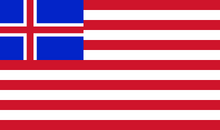 |

|
6,900,000 | Ylökaupunki |
| Haþmēre |  |

|
152,203,000 | Ōneida |
| Kaldland |  |

|
412,000 | Ingjaldssandr |
| Leirhofn |  |

|
5,818,160 | Hapargård |
| Makushima |  |

|
51,101,000 | Maxima |
| Northland |  |

|
111,250,000 | Springfyld |
| Oirthir |  |

|
7,202,000 | Hreodburn |
| Pacifia |  |

|
114,210,900 | Sacramentdūn |
| Shaoliang |  |

|
15,391,000 | Shaoliang |
| Hvidovia |  |

|
19,636,000 | Venesia |
| Sirenia |  |

|
25,331,500 | Faleapuna |
| Victoria |  |

|
5,123,000 | Sedlon |
| Visekia |  |

|
12,000,000 | Borstad |
| West Akrifa |  |

|
74,000,000 | Bēorgwick |
| West Indaesia |  |

|
20,000,000 | Kyngsburn |
| Widonia | 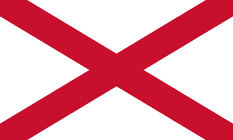 |

|
67,350,000 | Flōdceaster |
| Federal Territories | 
|
2,510,000 |
Foreign Relations
The Empire holds relations with many nations across the globe. It is a founding member of the Cynedrycan Commonwealth; a committee of nations who have at one point in their history been the sovereign territory of the nation of Cynedryca.
Ashia
The Empire has close relations with Ashia, who, after WWII, had their Emperor dethroned by the Cynedrycan military and replaced by a new Imperial family. Today, the two nations share military and economic ties, with Ashia under the protection of the Cynedrycan nuclear umbrella.
Treko
Treko and the Cynedrycan Empire have historically been rivals, with the relationship between the two Dominions turning hostile immediately after WWII.
Ninhundland
Ninhundland has been the traditional enemy of Cynedryca, with hostile relation culminating in the second world war in which the Ninhundish military invaded Gatland. After several years of combat, notably in Hallursvik, The Cynedrycan military pushed the Ninhundish back into their lands and dropped an atomic bomb on their country. Today, the hostilities have cooled, though some Cynedrycans are still distrustful of the Ninhundish.
Eladiastan
Cynedrycans hold generally negative views towards Eladiastan, with the Eladiastani Slave Trade and the Shaoliang Harbor Conflicts cited as contributing to those negative views. Officially, Cynedryca holds no official policy towards Eladiastan.
Law Enforcement and Crime
Economy
Cynedryca is a mixed high income economy characterized by large public spending and a multiple high level of state owned enterprises. While the collapse of the communist government in 1986 led to a massive wave of privatization, subsequent nationalization of various industries has led to the contemporary large public sector, which employs approximately 30% of the population. Nevertheless Cynedryca maintains majority private enterprises, though they are highly regulated by the federal, national, and Provincial governments.
Military
Her Majesty's Armed Forces operates strategic forces to attack hostile nations in the event of a homeland invasion, or to engage in the invasion of a foreign power. There are five branches of the Cynedrycan military; The Imperial Army, Imperial Navy, Imperial Air Force, Imperial Marines, and Revenue Marine Service. The Cynedrycan military operates on land, in the air, and in international waters. The Navy has traditionally been considered to be the most powerful navy of the world over the centuries, forming the heart of Cynedrycan military doctrine, with the Air Force playing a similar role.

Cynedrycan soldiers train in Seðissandur.
The Empire is a nuclear power, and still remains the only nation to use a nuclear weapon in warfare.
Internal Government
Government in Cynedryca adheres to the Federalist system. Power is divided among the Imperial government, national governments, the provincial governments, and local governments.
Most Provinces are further divided into counties, which may be issued a degree of authority by the provincial government. Nevertheless, they are not sovereign, and must comply to both provincial and
Provinces
Demographics
The population is estimated at 852,786,879. This makes it the second most populous country in the world, after Zheng.
| City | Metro Population | City population | Country | ||
|---|---|---|---|---|---|
    New Ambrose     |
New BrāwichhPenceasterWoodford | 50,876,155 | 30,834,000 | Haþmēre |   Newhampton   Syndmundham  New Eoforwic    |
| Flōdceaster | 26,320,000 | 19,539,000 | Widonia | ||
| Springfyld | 26,037,000 | 18,838,892 | Northland | ||
| New Ambrōse | 23,300,000 | 17,560,000 | Northland | ||
| Nakahama | 21,314,000 | 2,735,862 | Makushima | ||
| Angels | 20,103,000 | 10,329,000 | Pacifia | ||
| Halurswick | 19,533,040 | 14,539,021 | Gatland | ||
| Sainte Henri | 18,666,055 | 7,410,000 | Pacifia | ||
| HaruYukizawa | 10,701,000 | 3,800,000
1,474,000 |
Makushima | ||
| Newhampton | 10,500,000 | 5,635,127 | West Acrifa | ||
| Bēceweald | 10,315,000 | 6,030,000 | Gatland | ||
| Symundham | 9,101,000 | 8,102,181 | Gulland | ||
| New Eoforwic | 8,521,450 | 7,044,000 | Gulland | ||
| Monanflōd | 8,310,000 | 442,241 | West Indæsia | ||
| Shaoliang | 7,685,000 | 7,685,000 | Shaoliang | ||
| Fāirhæven | 7,000,699 | 3,331,444 | Northland | ||
| Maxima | 6,907,400 | 6,010,500 | Makushima | ||
| Itaqumi | 6,903,476 | 6,269,384 | Pacifia | ||
| Venesia | 6,200,000 | 5,601,911 | Hvidovia | ||
| Prynce Gyrg | 5,629,190 | 1,321,383 | Gatland |
Racial Composition
Because of its existence as a global empire, Cynedryca is home to people from a multitude of backgrounds. While being dominated by peoples of Widonic heritage, Cynedryca holds a significant minority of Ashian, Trekkish, Ninhundish, and Zheng groups. In West Akrifa, Akrifans the majority, whereas Nimbifer islanders and ethnic Widonians live in equal numbers in Oceania. A small population of Sikunese natives live in Northland.
Religion
According to the most recent census, taken in 2005, Widonic Christianity is the most prevalent religion in Cynedryca. After Christianity, Islam is the next largest religion, particularly practiced northern West Akrifa.
Culture
Language
Widonian is the dominant language spoken in Cynedryca. Native to Widonia, the language was brought to the new lands that the Empire colonized and gradually spread throughout the world. Widonian continued to be used even in now independent former colonies and its extent and importance is so great that it is considered the de facto lingua franca. Widonian is the sole official language of Cynedryca.
Widonian is an Eastern Merian West Eyjanic language. It is descended from Proto-Merian, itself originating from western Eyjan. When the Proto-Merians settled the Widlicetan Sea region, they would separate into multiple groups. The eastern Merians would be the ancestors to the Widonians and Frisians, a linguistic group referred to as Wido-Frisian. This puts Frisian as the closest non Widonic language to Widonian, however it is mutually unintelligible. Faldish is the third eastern Merian language, but is more distant from Widonian. Widonian is even more distantly related to the south Merian languages, which includes Branderlandish and Flondarians.
Widonian's closest relative is its fellow Widonic branch sibling, Oirthirian. Oirthirian is mutually intelligible with Widonian and is the language spoken by the descendants of the Widon-Seaxþ who migrated to northern Cynedrycia in the 6th century.
As a result of the ascension of the Nordain-Vizelian Magnūs I as King of Widonia in 1068, and the subsequent introduction of a significant number of Vizelian nobility, Widonian has an incredibly large Vizelian linguistic influence that separates it from any other Merian language. Over one third of words in Widonian originate from Vizelian, and the grammar has been changed to a significant degree, making it perhaps the most grammatically unique of the Merian languages.
Widonian is written in the Widonic Alphabet. Widonic is a descendant of the old Venesian alphabet.
While Widonian is the only official language of Cynedryca, there are dozens of languages belonging to a multitude of language families throughout the Empire. Several of these are legally recognized.
Uqausiq is the largest minority language in Cynedryca and is spoken in Northland. Officially, the Dominion of Northland has three official languages: Widonian, which is used in business and government, Uqausiq, which is commonly spoken by native Uqausiq peoples, and Northlandic, spoken by the minority Visekian community who have lived on the island for over 1000 years. Uqausiq is a native Anphilosian language belonging to the Eskimo language family. Within Northland itself, most signs are bilingual in Widonian and Uqausiq, although all Northlanders are totally fluent in both languages.
Gatlandic is a Venesic Eyjanic language spoken in Gatland. Descended from Ancient Venesian, the language was nearly extinct in the 18th century after facing centuries of repression by the Widonian-Gatlandic authorities. A wave of 19th century nationalism and Romanticism renewed interest in the Gatlandic language. By the 20th century, it was officially taught in schools as a secondary language. Today, 10% of the population of Gatland speaks Gatlandic, with a total number of over 13 million speakers who are mostly found in Seeland. Bilingual Widonian-Gatlandic signs are very common in Seeland, however outside of this province Gatlandic practically does not exist.
Literature
"Cynedrycan literature" refers to literature associated with all of Cynedryca. Most Cynedrycan literature is in the Widonian language, however tens of thousands of books are published in other Cynedrycan languages per year, the most common of these being Uqausiq. The Widonian playwright and poet Percival Whīte is widely regarded as the greatest dramatist of all time.
Music
Visual Art

Mr. And Mrs.Andrews, painted by Thomas Alan in 1750 and among the most iconic of Cynedrycan works.
The history of Cynedrycan visual art forms part of western art history.
Cuisine
Cynedrycan cuisine is incredibly diverse and varied, with dozens of cultures across the Empire each hosting their own unique dishes. In addition to these ethnic dishes, a huge variety of fusion cuisines exist, blending the elements of multiple cuisines from across Cynedryca into new dishes, or incorporating traditional elements of one culture's cuisine into another. Colonialism and trade introduced exotic spices into traditional Eyjanic and Widonian cuisines, the most notable of which coming from Indaesia and Anphilos, the latter of which introduced dozens of new crops from the new world into the old and forever changed the ingredient makeup of Eyjanic cuisine.
Sports

Victoria Blacks, the national football team of Victoria.
Rugby union football, tennis, table tennis, badminton, Gullandic football, baseball, rugby league, rugby sevens, golf, boxing, netball, water polo, field hockey, billiards, darts, rowing, and rounders originated or were substantially developed in Cynedryca, with the rules and codes of many modern sports invented and codified in the late 19th century Victorian Cynedryca. Unlike many countries, where association football is the predominate sport, rugby football dominates in Cynedryca and thus "football" refers to rugby.
A 2003 poll found that football is the most popular sport in Cynedryca, with baseball and ice hockey close behind.
Media
The ᚳᛒᚳ (CBC), founded in 1922, is Cynedryca's publicly funded radio, television and Internet broadcasting corporation, and is the oldest and largest broadcaster in the world. It operates numerous television and radio stations in Cynedryca and abroad and its domestic services are funded by tax dollars. The CBC World Service is an international broadcaster owned and operated by the CBC. It is the world's largest of any kind. It broadcasts radio news, speech and discussions in more than 40 languages.
Cinema and Theater
Angels is commonly dubbed as the "entertainment capital of the world" and is the center of the Widonian language film industry, the most widespread in the world. Angels is also home to much of the Cynedrycan music industry, with numerous record labels headquartered in the city.
The central hub of theater in Cynedryca is located in New Brāwichh. Many cities have professional regional or resident theater companies that produce their own seasons, with some works being produced regionally with hopes of eventually moving to New Brāwichh. The biggest-budget theatrical productions are musicals. Cynedrycan theater also has an active community theater culture, which relies mainly on local volunteers who may not be actively pursuing a theatrical career.
Infrastructure
Transportation
Roadways
An intricate system of highways connects cities throught Cynedryca. Following the Second World War, the government invested in a series of interstate highway programs to thoroughly connect and provide quick and simple transportation between the Provinces. The Cynedrycan freeway was born in Haþmēre during the 1940s. The concept would quickly be adopted by the federal government, which established the Federal Highway Commission in 1953. As the years progressed, the freeway system grew in size and scope. Today, highways are administered at multiple levels.
Federal highways are the highest level, and are numbered by the Federal government. These have ᚠ (F) as a prefix. Ex: ᚠ323 (F323) being the primary north-south highway in western Gatland.
Dominion Highways are numbered and maintained by the Dominons. They are prefixed with ᛞ (D).
Provincial highways are numbered and maintained by the provinces and are prefixed with ᛈ (P).
Air Transport
The civil airline industry is both privately and publicly owned, and is one of the largest airline industries in the world. As of 2014, the three largest Cynedrycan based airlines are; Imperial Airways, Mūþa Airlines, and Western Airlines.
Rail

A CONRAIL train in Visekia.
All of Cynedryca's major railroads are publicly owned. Contemporary Cynedryca is home to multiple highspeed railways located throughout the Empire. These include Consolidated Railways (CONRAIL), which serves the Brytic Isles and Eporīce, Pacifian Railways (PRW), Haþrail in Haþmēre, Shaoliang Railways, and Northland Rail.
Energy
Production of electricity in Cynedryca is a state operated sector. Nuclear power contributes to the vast majority of the nation's power generation, followed by hydroelectric and natural gas. In recent years, there have been both private efforts and governmental concerns to reduce pollutants output in the nation, leading to a push for cleaner energy. Nuclear fusion is being researched and developed by scientists throughout the nation, it is not expected to become a viable energy source within the next decade. Coal burning plants were phased out during the environmental concerns of the 1970s, and now only constitute a small percentage of energy production. The trend towards renewable energy has encouraged the development of solar and wind farms in the central Provinces.
